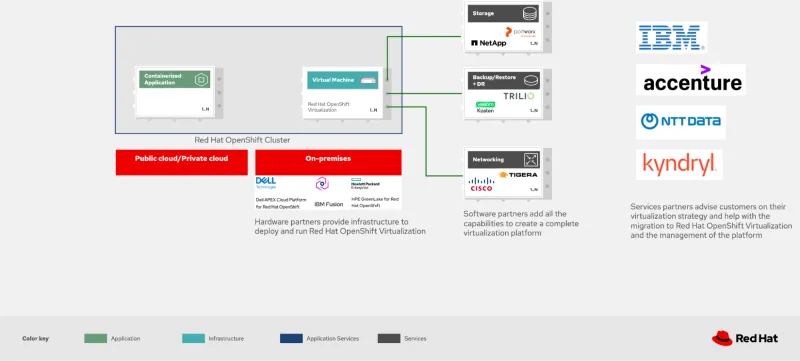Virtualization technologies have long played an important role in corporate IT strategies. Once a vendor choice is made, companies typically keep their virtual machine (VM) estate on the same platform for years, rarely shopping around for new options.
Recent market changes have opened the door for new VM solutions and vendor considerations, including the possibility of application modernization. Most companies have understood the importance of adopting new ways to deploy and manage the lifecycle of their applications, but they have also realized that the required technologies often call for platforms that are radically different from those used by their applications running on VMs. This means adding complexity to their IT infrastructure, increasing costs and difficulty for administrators.
That said, however, organizations are realizing that maintaining their current virtualization platform is no longer convenient or cost effective. So if you're going to move your applications that need to run on VMs, why not choose a platform where you can also benefit from modern applications that are cloud-native and run in containers?
This is what Red Hat OpenShift offers—a single platform where you can deploy, run and manage all your applications, whether they are legacy (thanks to Red Hat OpenShift Virtualization) or modern. With OpenShift, you'll gain both cost savings and ease of operation.
Red Hat OpenShift Virtualization and partners
Red Hat also has an extensive partner ecosystem, and this is particularly important when it comes to selecting a new virtualization platform. Where other platforms offer out-of-the-box solutions with predefined technologies, OpenShift Virtualization allows you to choose the solutions that best suit your needs in terms of networking, storage and data protection. The partners in the Red Hat partner ecosystem are certified, so you can rest assured that their software will run smoothly on OpenShift.
If, for example, customers wish to keep using the storage solution they have in their current virtualization platform, they can bring it to OpenShift Virtualization. But if they are looking for another option, moving to OpenShift Virtualization will let them reassess and possibly choose a new vendor that offers them a better solution for their use cases. Some of the storage vendors that partner with Red Hat are NetApp and Portworx.
When it comes to data protection, partners like Portworx, Trilio and Veeam Kasten offer robust and innovative solutions for backup/restore, disaster recovery and ransomware protection.These help with data security and availability wherever OpenShift clusters are deployed, including on bare metal, private cloud or public cloud.
Security is another important consideration when choosing an application platform. It’s essential to control network segmentation and to define and apply clear network policies so that each team has access to the resources they need. Some Red Hat partners that provide networking solutions for OpenShift are Cisco, F5 and Tigera.
The Red Hat partner ecosystem is not limited to software and hardware. It also includes a wealth of services partners that can help advise customers on potential solutions. Depending on their use cases and needs, service partners can help customers smoothly migrate to OpenShift Virtualization and establish seamless administration of the platform once the migration has been completed.

Wrapping up
OpenShift Virtualization offers a comprehensive alternative to legacy virtualization platforms. It helps customers avoid vendor lock-in and rising costs so they can continue to manage their applications that run on VMs, just as they used to do on their previous solutions. It also provides the foundation for modernizing their applications when they are ready to do so at their own pace. Having a single platform for all types of applications can help lower costs and simplify administration tasks.
The vast Red Hat partner ecosystem gives customers the ability to build their solution exactly as they want, without having to go with solutions imposed by other platform vendors.
Learn more about Red Hat OpenShift Virtualization, and check the full list of infrastructure and services partners that complete a robust virtualization platform. If you want to start exploring migrating to Red Hat OpenShift Virtualization, check out this architecture.
Prova prodotto
Red Hat OpenShift Container Platform | Versione di prova del prodotto
Sull'autore
Ricardo Garcia Cavero joined Red Hat in October 2019 as a Senior Architect focused on SAP. In this role, he developed solutions with Red Hat's portfolio to help customers in their SAP journey. Cavero now works for as a Principal Portfolio Architect for the Portfolio Architecture team.
Altri risultati simili a questo
F5 BIG-IP Virtual Edition is now validated for Red Hat OpenShift Virtualization
Red Hat OpenShift Virtualization: The strategic platform for virtualization customers
Machine learning model drift & MLOps pipelines | Technically Speaking
Building a foundation for AI models | Technically Speaking
Ricerca per canale
Automazione
Novità sull'automazione IT di tecnologie, team e ambienti
Intelligenza artificiale
Aggiornamenti sulle piattaforme che consentono alle aziende di eseguire carichi di lavoro IA ovunque
Hybrid cloud open source
Scopri come affrontare il futuro in modo più agile grazie al cloud ibrido
Sicurezza
Le ultime novità sulle nostre soluzioni per ridurre i rischi nelle tecnologie e negli ambienti
Edge computing
Aggiornamenti sulle piattaforme che semplificano l'operatività edge
Infrastruttura
Le ultime novità sulla piattaforma Linux aziendale leader a livello mondiale
Applicazioni
Approfondimenti sulle nostre soluzioni alle sfide applicative più difficili
Virtualizzazione
Il futuro della virtualizzazione negli ambienti aziendali per i carichi di lavoro on premise o nel cloud
